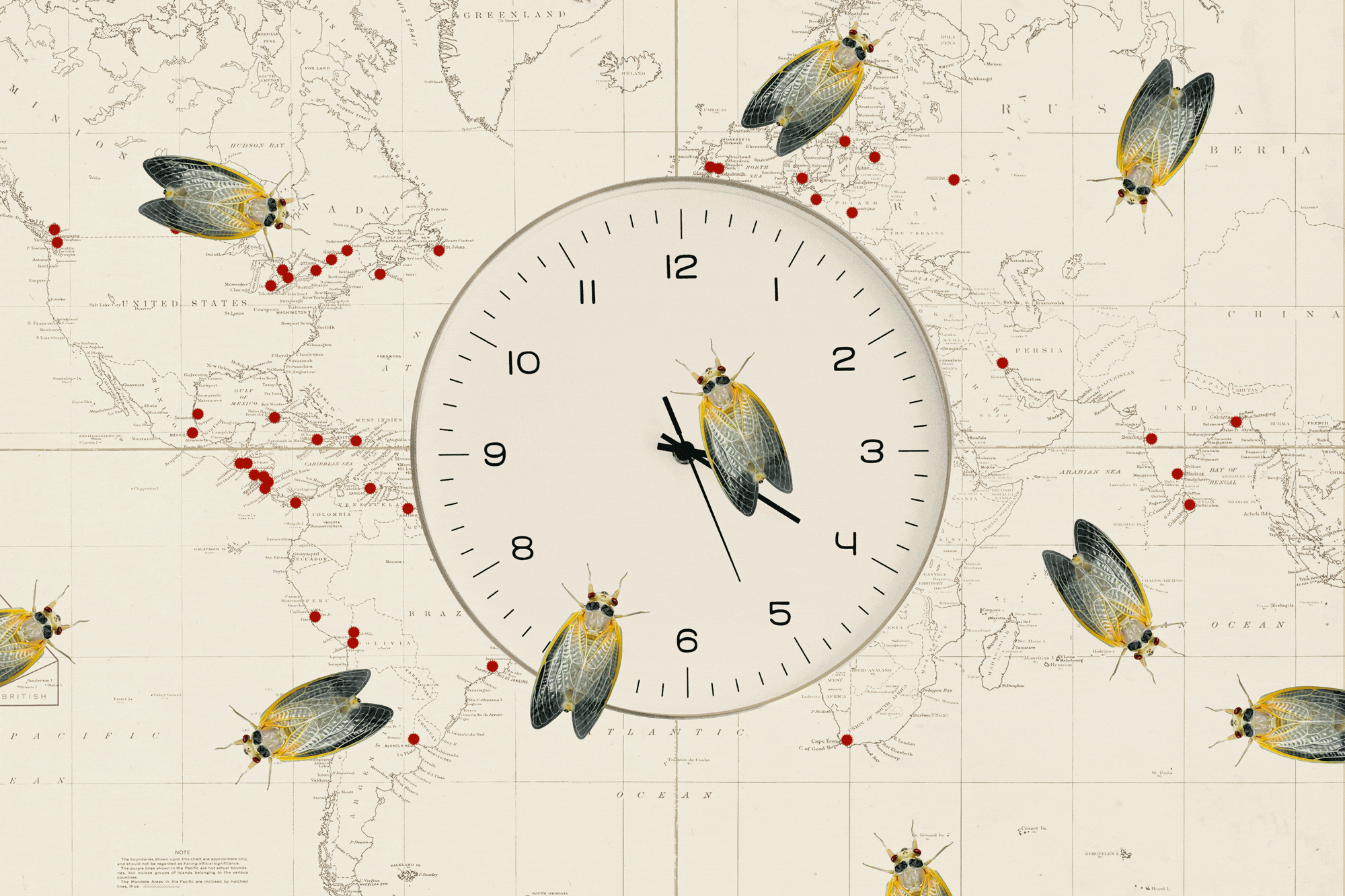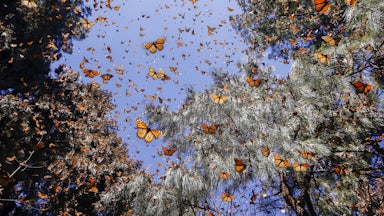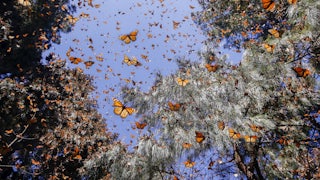They went to ground as John Kerry was “reporting for duty” at the Democratic National Convention, deftly avoiding the release of Princess Diaries 2 a few weeks later. They’ve missed the launch of Twitter, the birth of the gig economy, and Brexit. Now, after 17 years sipping tree roots in the soils of North America’s deciduous forests, billions of cicadas are reemerging into a world dramatically altered by the coronavirus. Fortunately, unlike the last plague that forced people indoors, almost as soon as these (harmless) cicadas swarm, they’ll be gone. But their scheduled debut will serve as a spectacular reminder of the perils and possibilities of transformation.
Most of the more than 3,000 global species of cicadas are “annuals,” reappearing every summer. But a handful of species—including one in India, one in Fiji, and seven in the eastern United States—are more patient. In the U.S., broods of so-called “periodical” cicadas spring up once every 13 or 17 years to sing, lay eggs, and die, all in about a month. For the brief period they’re above ground, their orgiastic choirs can reach a pitch of about 85 decibels, on par with a power lawnmower. And then, they plunge back into silence.
Scientists have spent a lot of time trying to understand how cicadas got this way. One leading theory is that their periodicity emerged during glacial periods, which made it more useful for the insects to ascend all at once, instead of when individuals reached an ideal size. In rooting its reproductive strategy in prime numbers (13- and 17-year cycles are a rarity in nature), the defenseless bug made it even harder for potential predators to synchronize with them. And their sudden onslaught serves another purpose: “They simply overwhelm anything that might eat them,” Eric Day, an entomologist at Virginia Tech, told me.
The precision of the cicada’s song might make these species an important—and unignorable—doomsday clock. Genetic data suggests the insects have followed their numerical rules for about 1.8 million years. Yet for every cyclical swarm, a fraction of periodical cicadas inevitably miscalculate, crawling up from the depths four years off-cycle. No one is certain what causes such stragglers, or if they’re becoming more frequent. But if it’s the result of a mismatch between the insects’ internal timepiece and the signals they receive from their environment, then anthropogenic climate change could exacerbate these challenges. While periodical cicadas have weathered serious shifts before, “what’s different now is that [climate] change is going very fast,” John Cooley, an assistant professor in residence at the University of Connecticut, told me.
Even if periodical cicadas can ride out the effects of our unmitigated greenhouse gas emissions for years to come, their scheduled emergence feels particularly timely this spring, as our own newly vaccinated hordes emerge from forced isolation and stream into public spaces to mate, eat, and molt (in this case, our athleisure). While we may look and feel different, the frenetic life cycle of the cicada reminds us of what we’ve lost in the pandemic, what we’ve learned, and how far we still have to go.
The love songs of the cicada are generated by the rapid buckling of the males’ ribs. The sound has inspired ancient fables and enduring poetry. Socrates told the story of how humans encountering music for the first time were so overwhelmed they died, only to be transformed by the Muses into “the race of cicadas.” In China’s Han dynasty, the dead were buried with jade cicadas on their tongues, a symbol of change. More recently, Alison Bechdel described in her 2006 graphic memoir, Fun Home: A Family Tragicomic, the way cicadas “shook loose the screws on some collective libidinal impulse.”
That could make for an interesting soundtrack to the “hot vax” or “shot girl” summer as lockdowns loosen. Before pandemic travel restrictions, people came from all over the world to see the red-eyed, translucent-winged cicadas at their peak. “This is really the most outstanding spectacle of its type,” Cooley said. But others may consider the insects another reason to keep quarantining. “I got a temporary Xanax prescription for a cicada emergence that was very intense in our neighborhood. It literally allowed me to leave the house,” nature writer Emma Marris recently tweeted. “I ❤ all living things. I just can’t with the way cicadas CLASP ONTO YOU when they land on you.”
Prior generations of Americans have felt similarly wary of the winged rattlers. When European settlers first encountered the pinkie-size insects in their newly established colonies, they called them locusts, mistaking them for a Biblical punishment. Today, we know these bugs don’t bite, sting, or spread deadly diseases; they hardly even damage crops. Yet their sheer density—up to 1.5 million per acre—can feel like an affront. Insects always outnumber us, but only periodical cicadas have the audacity to make it known.
People have confronted this feeling a lot lately: The sheer scale of the pandemic has often been incomprehensible, from the early exponential growth to the latest death toll. Climate change, in the words of philosopher Timothy Morton, is a “hyperobject”—a problem “so big and so powerful,” intangible yet urgent, that coping with it “requires a kind of mental upgrade.” Cicadas may not pose a threat to us, but their existence offers as great a challenge: Like “living fossils” or shifting tectonic plates, they dispute the primacy of the human experience of time.
Periodical cicadas may have evolved in the shifting climates that gave rise to humankind, but what human-caused climate change will do to these insects remains to be seen. This month, entomologists like Cooley will collect cicada census data in the hopes of finding out. Scientists have observed large premature swarms in 1969, 2003, and 2020 in Chicago, and in 2017 in Cincinnati, Baltimore, and Washington, D.C. The question is, were these an acceptably small percentage of the overall broods in those areas? Or are increasing numbers of cicadas losing track of time?
We already know other human activity has had more immediate consequences for periodical cicada populations: In the late nineteenth century, Brood XXI of Florida went extinct. Around 1954, Brood XI in Connecticut followed suit. And other groups are shrinking all the time. “Oftentimes, it’s obvious things, like their forest got developed into a mall,” Cooley said. “That’s the end.”
Even with careful counting and advances in genetic research, much about the cicada’s life is sure to remain a mystery. “We’re never going to be doing longitudinal breeding studies with these kinds of things, because we’re not going to be alive long enough,” Cooley says. People who want to experiment with evolution typically use fruit flies. Cicadas operate on a timescale that resists sustained observation.
Brood X should emerge again in 2038. What kind of world will it find?
Humans face a series of decisions that will shape our future—and that of the planet. While many Americans can now safely leave their houses, the Covid-19 crisis in India is raging. New variants are swirling, threatening to undermine the efficacy of our hard-won vaccines. And the climate crisis, which for more than a year has simmered on the psychological back burner, is only accelerating. If there’s one lesson to learn from the cicadas, it’s that we’re racing against the clock.








